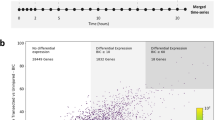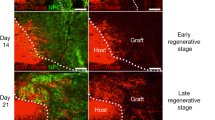Abstract
DURING normal vertebrate development, about half of spinal motoneurons are lost by a process of naturally occurring or programmed cell death1,2. Additional developing motoneurons degenerate after the removal of targets3,4 or afferents5. Naturally occurring motoneuron death as well as motoneuron death after loss of targets or after axotomy can be prevented by in vivo treatment with putative target (muscle) derived or other neurotrophic agents6–8. Motoneurons can also be prevented from dying in vitro9–12 and in vivo (Y.Q.-W., R.W., D.P., J. Johnson and L. Van Eldik, unpublished data and refs 7, 13, 14) by treatment with central nervous system extracts (brain or spinal cord) and purified central nervous system and glia-derived proteins. Here we report that in vivo treatment of chick embryos with brain-derived neurotrophic factor rescues motoneurons from naturally occurring cell death. Furthermore, in vivo treatment with brain-derived neurotrophic factor (and nerve growth factor) also prevents the induced death of motoneurons that occurs following the removal of descending afferent input (deafferentation)5. These data indicate that members of the neurotrophin family can promote the survival of developing avian motoneurons.
This is a preview of subscription content, access via your institution
Access options
Subscribe to this journal
Receive 51 print issues and online access
$199.00 per year
only $3.90 per issue
Buy this article
- Purchase on Springer Link
- Instant access to full article PDF
Prices may be subject to local taxes which are calculated during checkout
Similar content being viewed by others
References
Hamburger, V. J. comp. Neurol. 160, 535–546 (1975).
Oppenheim, R. W. A. Rev. Neurosci. 14, 453–501 (1991).
Hamburger, V. Amer, J. Anat. 102, 465–410 (1958).
Oppenheim, R. W., Chu-Wang, I. W. & Maderdrut, J. L. J. comp. Neurol. 177, 87–112 (1978).
Okado, N. & Oppenheim, R. W. J. Neurosci. 4, 1639–1652 (1984).
Oppenheim, R. W., Haverkamp, L. Prevette, D., McManaman, J. & Appel, S. Science 240, 919–922 (1988).
Oppenheim, R. W., Prevette, D., Qin-Wei, Y., Collins, F. & MacDonald, J. Science 251, 1616–1618 (1991).
Sendtner, M., Kreutzberg, H. & Thoenen, H. Nature 345, 440–441 (1990).
Dohrmann, U., Edgar, D., Sendtner, M. & Thoenen, H. Devl Biol. 188, 20–221 (ok?) (1986).
Dohrmann, U., Edgar, D. & Thoenen, H. Devl Biol. 124, 145–152 (1987).
Arakawa, Y., Sendtner, M. & Thoenen, H. J. Neurosci. 10, 3507–3515 (1990).
Block-Gallego, E. et al. Development 111, 221–232 (1991).
Bhattacharyya, A. et al. J. Neurobiol. (in the press).
Oppenheim, R. W., Prevette, D. & Fuller, F. J. Neurosci. (in the press).
Hofer, M. M. & Barde, Y.-A. Nature 331, 361–363 (1988).
Oppenheim, R. W., Maderdrut, J. & Wells, D. J. comp. Neurol. 210, 174–189 (1982).
Yan, Q., Snider, W. D., Pinzone, J. J. & Johnson, E. M. Neuron 1, 335–343 (1988).
Wayne, D. B. & Heaton, M. B. Devl Biol. 127, 220–223 (1988).
DiStefano, P. S. et al. Neuron 8, 983–993 (1992).
Marchetti, D., Haverkamp, L., Clark, R. C. & McManaman, J. Devl Biol. 148, 306–313 (1991).
Wayne, D. B. & Heaton, M. B. Devl Biol. 138, 473–483 (1990).
Ernfors, P. & Persson, H. Eur. J. Neurosci. 3, 953–961 (1991).
Maisonpierre, P. C. et al. Neuron 5, 501–509 (1990).
Hulst, J. R. & Bennett, M. Devl Brain Res. 25, 153–156 (1986).
Sendtner, M., Holtman, B., Kolbeck, R., Theonen, H. & Barde, Y.-A. Nature 360, 757–759 (1992).
Yan, Q., Elliott, J. & Snider, W. D. Nature 360, 753–755 (1992).
Sendtner, M. et al. Nature 358, 502–504 (1992).
Oppenheim, R. W., Prevette, D. & Cole, T. Devl Biol. 133, 468–474 (1989).
Author information
Authors and Affiliations
Rights and permissions
About this article
Cite this article
Oppenheim, R., Qin-Wei, Y., Prevette, D. et al. Brain-derived neurotrophic factor rescues developing avian motoneurons from cell death. Nature 360, 755–757 (1992). https://doi.org/10.1038/360755a0
Received:
Accepted:
Issue Date:
DOI: https://doi.org/10.1038/360755a0
This article is cited by
-
The potential therapeutic effect of platelet-rich plasma in the treatment of post-COVID-19 parosmia
The Egyptian Journal of Otolaryngology (2022)
-
Regulation of TrkB cell surface expression—a mechanism for modulation of neuronal responsiveness to brain-derived neurotrophic factor
Cell and Tissue Research (2020)
-
Role of BDNF in Central Motor Structures and Motor Diseases
Molecular Neurobiology (2013)
-
Melanocytes: A Window into the Nervous System
Journal of Investigative Dermatology (2012)
-
Low-Dose Memantine Attenuated Morphine Addictive Behavior Through its Anti-Inflammation and Neurotrophic Effects in Rats
Journal of Neuroimmune Pharmacology (2012)
Comments
By submitting a comment you agree to abide by our Terms and Community Guidelines. If you find something abusive or that does not comply with our terms or guidelines please flag it as inappropriate.



